Celebrate special occasions with this royal Ras Malai, or rossomalai, an Indian dessert made with soft and sweet paneer dumplings that are soaked in a fragrant saffron-flavored cream. Top them with pistachios and almonds, and serve them for special guests or at your Diwali party!
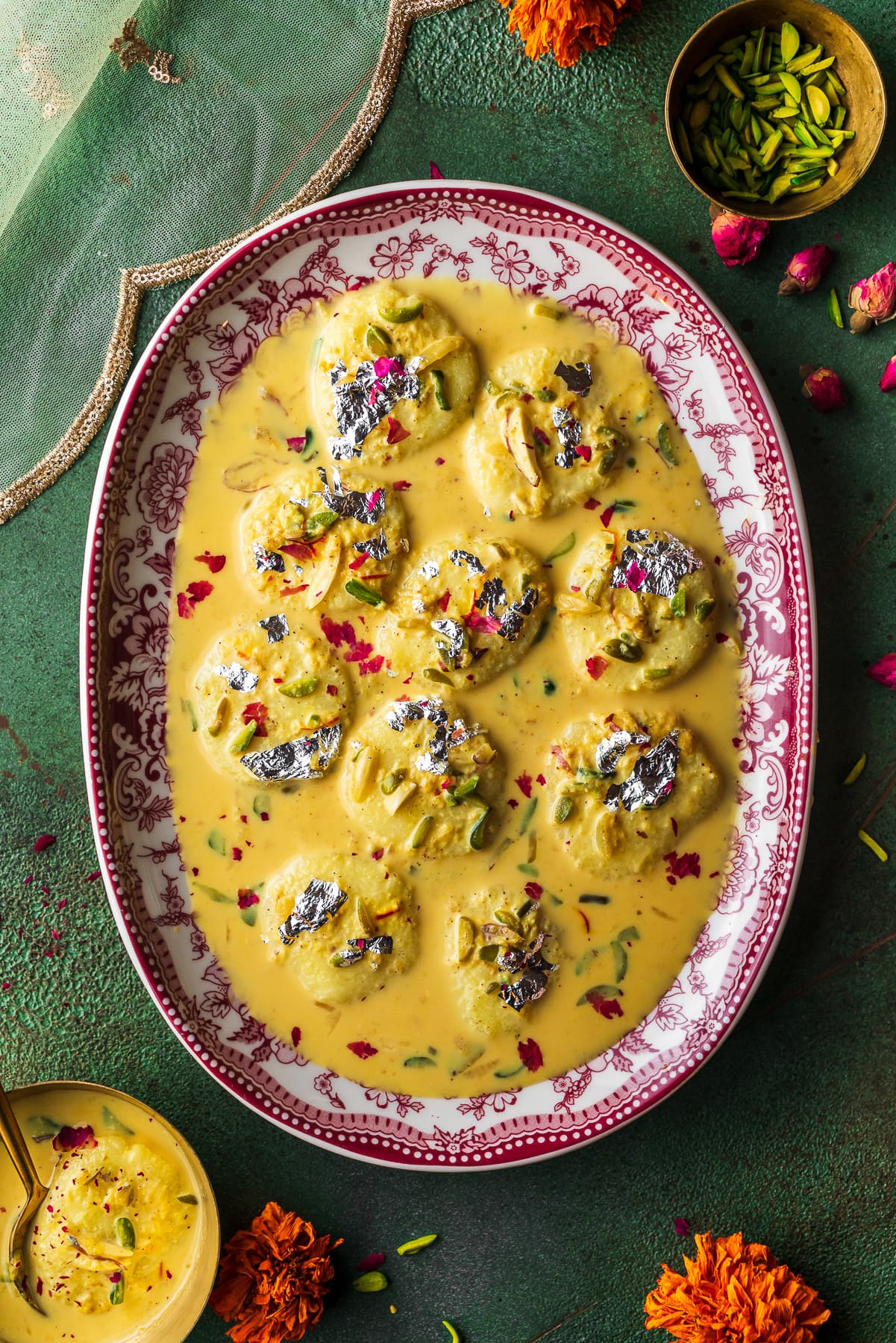
Jump to:
Admittedly, Ras Malai is one of my favorite Indian desserts. It's one of the more popular ones along with gulab jamun and jalebi. You can find it at a majority of Indian restaurants. But there's nothing quite like making it fresh at home, as sometimes restaurants pre-made Ras Malai.
This homemade kesari Ras Malai results in pillowy soft balls of chenna that soak up a luxurious malai made with saffron, cardamom, and rosewater. They're juicy, sweet, and fragrant. They're a MUST for any dinner party, special occasion, and definitely deserve an appearance during Diwali celebrations!
What is Ras Malai?
Ras Malai is a popular mithai in India that's made with fresh milk curds, or chenna. It is kneaded into a dough and then shaped into little balls or discs. The chenna balls are boiled in simple syrup before they're transferred and soaked in malai that's flavored with saffron, cardamom, chopped nuts. "Ras" means juice, and "malai" means cream in Hindi, referring to how juicy the chenna balls are after boiling in sugar syrup and soaking in malai.
The dessert is said to have originated in the eastern region of the Indian subcontinent in the 1900s, although the exact origin has been impossible to verify. The main two claims to the creation of Ras Malai are by K.C. Das Grandsons in the Bengal region of India and Matri Bhandar in Bangladesh.
Ingredients - Notes and Substitutions
There's three different portions to Ras Malai we need to prepare - the soft and scrumptious chenna balls, the simple syrup for boiling the chenna balls, and the luscious saffron malai to soak the chenna balls in.
Chenna Balls
Making the chenna balls is the exact same process as making paneer.
Use whole milk, and whole milk only. Other milks such as 2% on non-fat probably won't have enough milk fat to make a lot of paneer. Buffalo milk and goat milk can also be used to make paneer.
To curdle the milk, use lemon juice or vinegar. If you're using vinegar, be sure to rinse out the chenna so the taste of vinegar isn't in the ras malai.
Corn flour helps with kneading the chenna into a dough. Substitute with corn starch.
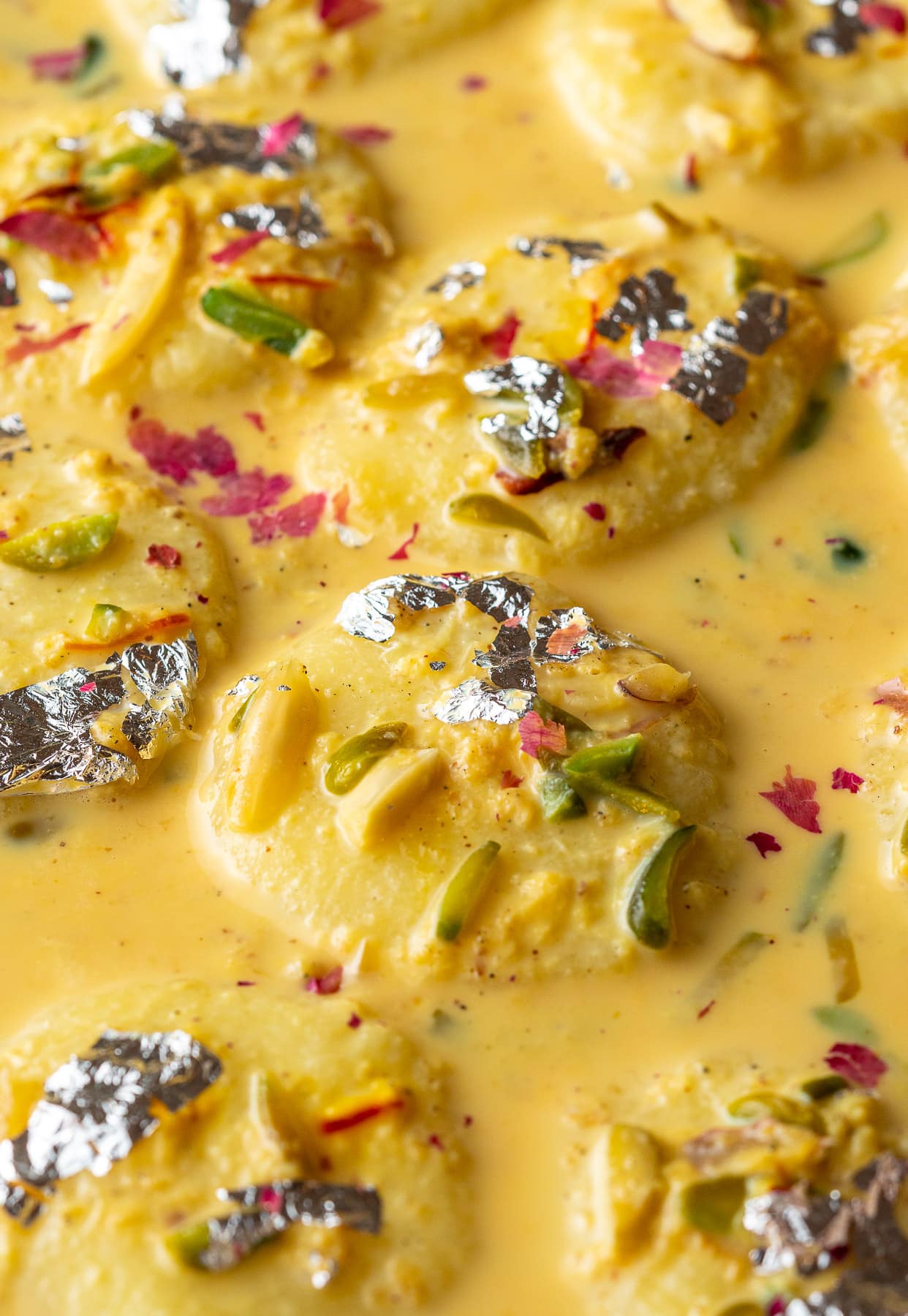
Simple Syrup
The simple syrup is not a classic 1-to-1 ratio of sugar to water. This has more water so that the chenna balls soak up the liquid and expand while being lightly sweetened.
Malai
Malai is the "cream" part of Ras Malai. It's essentially sweetened whole milk simmered with kesar (saffron), almonds, pistachios, cardamom, and any other mix-ins like rosewater. It's almost like rabdi without the process of collecting the layers of cream.
For the cardamom, it's ideal to use lightly crushed whole pods to flavor the milk and then remove them later. However, the powder works as well. It just won't be as strong and fragrant with the saffron being the main spice to flavor the cream.
There's a few ways to make the malai. Simmering whole milk until it reduces by half is the most popular. Some also use heavy cream and sweetened condensed milk to make it especially luscious and thick.
How to Make Ras Malai
There's 3 main components to making Ras Malai. First is making the malai so that it has time to reduce over heat. Then, making the chenna, kneading it into a dough, and shaping it into balls. The last step is to boil the chenna balls in a sugar syrup before transferring them to the malai to soak for a few hours.
1. Simmer Saffron Malai
Let's start with making the malai. Malai means "cream". It's similar to rabdi, where the cream is skimmed off the top of milk as it simmers.
Start by bringing whole milk to a boil in a pot while stirring in intervals to make sure the milk doesn't burn. Add the slivered almonds and pistachios, the saffron, sugar, and cardamom. Bring the milk down to a simmer and let it continue on low to medium heat for 15-20 minutes, or until it's reduced by half.
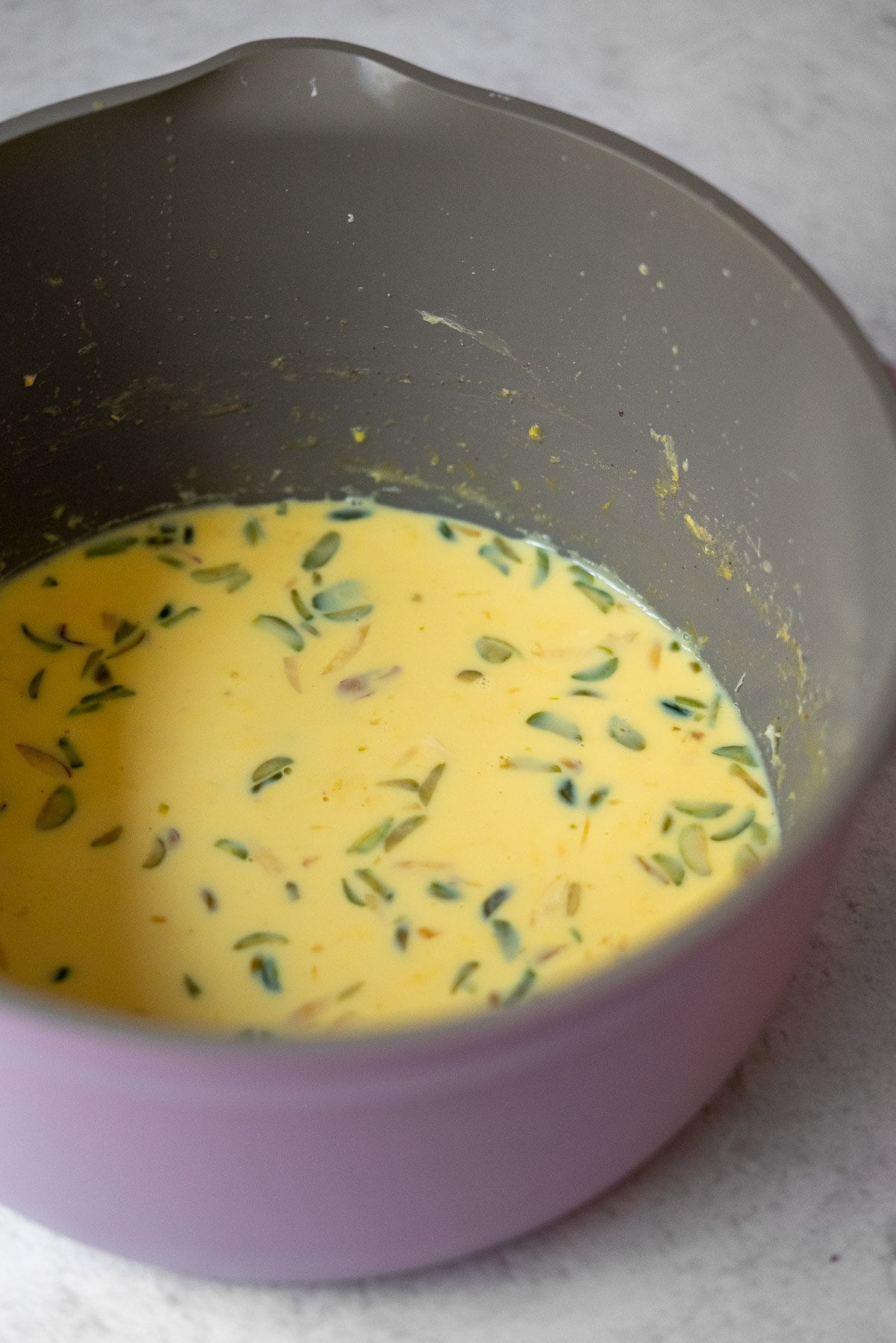
Remove the pot from heat and stir in the rosewater. Set the malai aside.
This method results in a deeply turmeric-colored malai from the saffron. If you'd like a white malai, add the saffron at the end and it'll still have a light taste of saffron.
2. Make Fresh Paneer and Create Chenna Discs
Now it's time to make the paneer, or chenna! Chenna and paneer are not the same. Paneer is a cheese that's made out of chenna, or milk curds. The process is entirely the same as making paneer. However, the chenna isn't pressed into a cheese.
I start boiling the milk for the chenna at the same time as I'm making the malai.
Equipment
For making paneer you'll need the following equipment:
- A heavy bottom pot. Since we are bringing the milk just up to a boil, heavy bottom pots are ideal for making sure the milk doesn't burn on the edges.
- A food thermometer. Bringing the milk up to the correct temperature is key to making great paneer. You can also watch for when the milk starts to bubble on the sides.
- A cheese cloth. For capturing the milk curds and draining the whey. The less whey in the end product, the better.
- A large strainer. For draining out the whey.
- Mixing bowl. Something to drain the whey into.
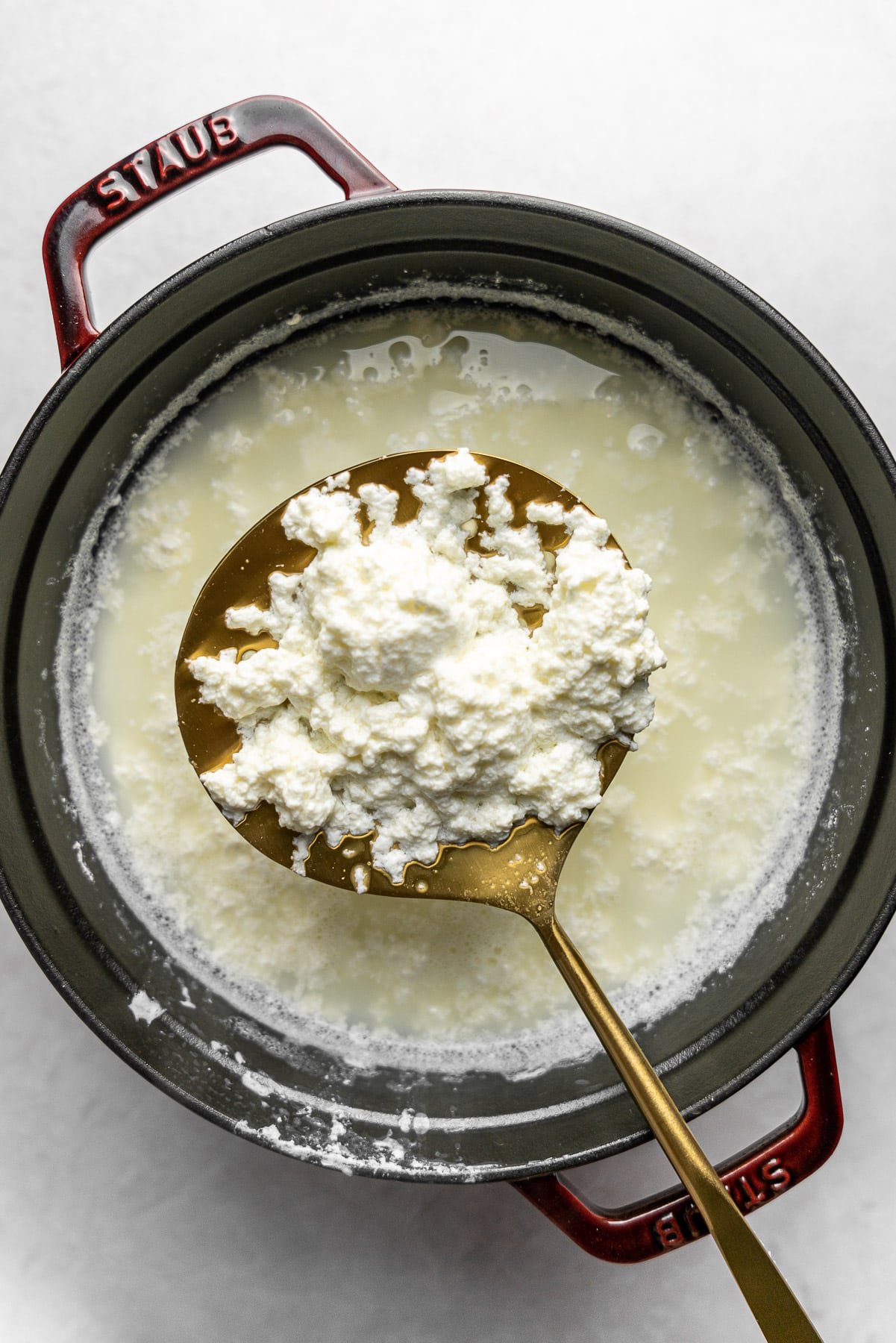
Pour the milk into a heavy bottom pot that holds at least 4 quarts of liquid. Using a food thermometer, bring the temperature up to a boil (ideally around ~203°F) on medium heat, stirring occasionally to prevent the milk from burning.
Once the milk just reaches a boil, turn off the heat and disperse the lemon juice all over. Use a slotted spoon to give the milk a good stir. Let the milk sit for ten minutes without touching it. After 10 minutes, there will be signs that the curds have started separating from the whey when you see a yellow liquid. Use the slotted spoon to stir again to separate the curds. Add ice into the pot to prevent the curds from cooking any further.

Drain the milk curds in a cheesecloth 
Strain out as much whey as possible 
Wrap up the milk curds in the cheese cloth
Prep the draining station by placing a large mesh strainer over a large bowl. Place a cheese cloth over the strainer. Slowly pour the milk curds and whey over the cheese cloth. Use a spoon to press the whey out. If you used vinegar, this is when you would rinse it out using warm water.
Tightly wrap the milk curds in the cheese cloth. Begin twisting and pressing the cheese to get as much whey out as possible. Some people even hang the ball of cheese in the cheese cloth off of their kitchen sink faucet for half an hour to allow gravity to bring the whey to the bottom.
At this point the chenna should be moist but not dry. A very small amount of whey left in the milk curds is ideal for soft ras malai. Transfer the chenna into a bowl or wooden board and add about a teaspoon of corn flour.
Knead the chenna until the milk curds are smooth. A good way to do this is by smearing a small portion of the chenna against the surface you're using and then folding it back into the larger portion. Continue doing this until it's completely smooth and is almost like a dough.
Roll the chenna out into a log and cut it into 12 pieces that weigh around 20 grams each. Flatten the chenna pieces in the palm of your hands to create the chenna discs that are a bit ~ rustic ~ and oval-ish. Alternatively, roll them into a ball and use a smooth surface to flatten them to get a perfect circle.
Note: The weight of the chenna pieces depends on how much of the milk curds separates from the whey. I had around 240 grams of chenna. Do your best to get 12 equal sized pieces of whatever weight. If you like them thicker or larger, make each piece around 30-35 grams each.
Yet another option is to leave the chenna as balls for boiling in the sugar syrup. This helps get an even cook on them. Then, flatten them with the back of a spoon while squeezing out the excess syrup. The drawback is that they easily crack after they are boiled.
3. Boil in Simple Syrup
Bring water to a boil in a wide pan. Add in the sugar and stir until it has dissolved. Carefully transfer the chenna balls into the syrup. Ideally, none of them should touch, nor should they touch the bottom of the pan. Boil them for 10-15 minutes, or until they double in size.
Once they've doubled in size, carefully remove them one by one using a slotted spoon. Press each chenna ball with the back of a spoon to remove excess syrup and transfer them to the malai.
4. Soak Chenna in Saffron Milk
Transfer the chenna balls to the malai that we we made earlier. It's best to set the chenna balls in a baking dish in a single layer. Then, pour the warm malai over the chenna. Note that the malai should still be warm! Spoon the malai over the chenna to fully coat them.
Cover the baking dish with plastic wrap and chill it in the refrigerator for a minimum of 3-4 hours. The chenna balls will soak in the malai all the way to it's center.
Serving Suggestions
Ras Malai is a great option for a large party!! Serve the Ras Malai chilled in a platter for a dessert option. Top it with strands of saffron, pistachios, and dried rose petals. To make it extra fancy, add edible silver foil as well!
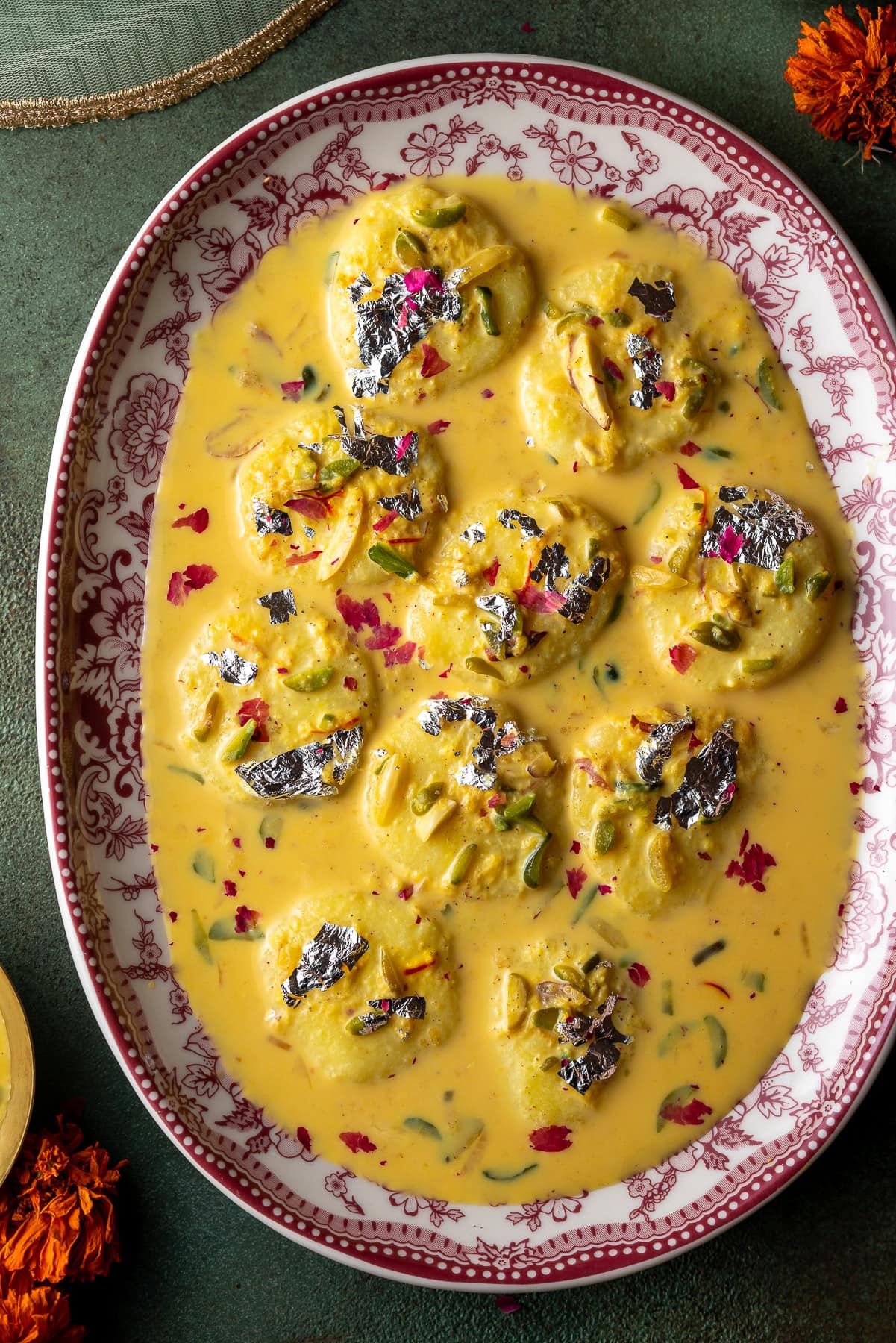
The ideal serving size is two chenna balls with a few tablespoons full of the malai to accompany it.
Tips for the Softest Chenna Dumplings
Achieving soft chenna is arguably the most important part of getting the best ras malai. There are a few key moments that can take your chenna discs from soft and scrumptious to hard and dense.
- Curdling the milk. Add just enough of the acidic agent (lemon juice or vinegar) to curdle the milk. Too much and the chenna will be grainy. Once the milk curdles, immediately add ice water into the pot to stop them from cooking any further.
- Moist vs. dry chenna. The chenna should be moist but not dripping with whey. The texture shouldn't be sticky, grainy, or crumbly after kneading it into a dough. If it's too dry, add a tiny bit of whey at a time until the chenna rehydrates into the right texture. However, too much whey in the chenna and it'll start to dissolve in the simple syrup. If it's too moist, transfer it back to the cheesecloth and hang it from the kitchen sink faucet for 20-30 minutes until it's easier to work with. Try not to add more corn flour, otherwise the discs will be hard and won't soak up any liquids.
- Kneading the chenna. If you smear a bit of chenna on to a surface and it's smooth instead of grainy, then it's ready to shape into the discs. Don't overknead it to the point that the fat starts to separate.
- Boiling in simple syrup. Over boiling the chenna in the sugar syrup can make them way too hard. It should only take 10-15 minutes, or until they've doubled in size.
- Warm saffron malai. The malai should still be warm when the boiled chenna dumplings are transferred in. It'll help them soak up the malai as it cools, and it'll continue to soak the malai as it chills.
Make Ahead Instructions
The chenna is best when it's made fresh at home. It can be kept in the fridge for up to 2 days, and then boiled in the syrup. Another hack is to purchase pre-made rasgulla, squeeze as much of the syrup out as possible, and then soak it in homemade malai.
Ras Malai is perfect for making a day ahead! The longer the chenna balls soak in the malai, the softer and more flavorful they are.
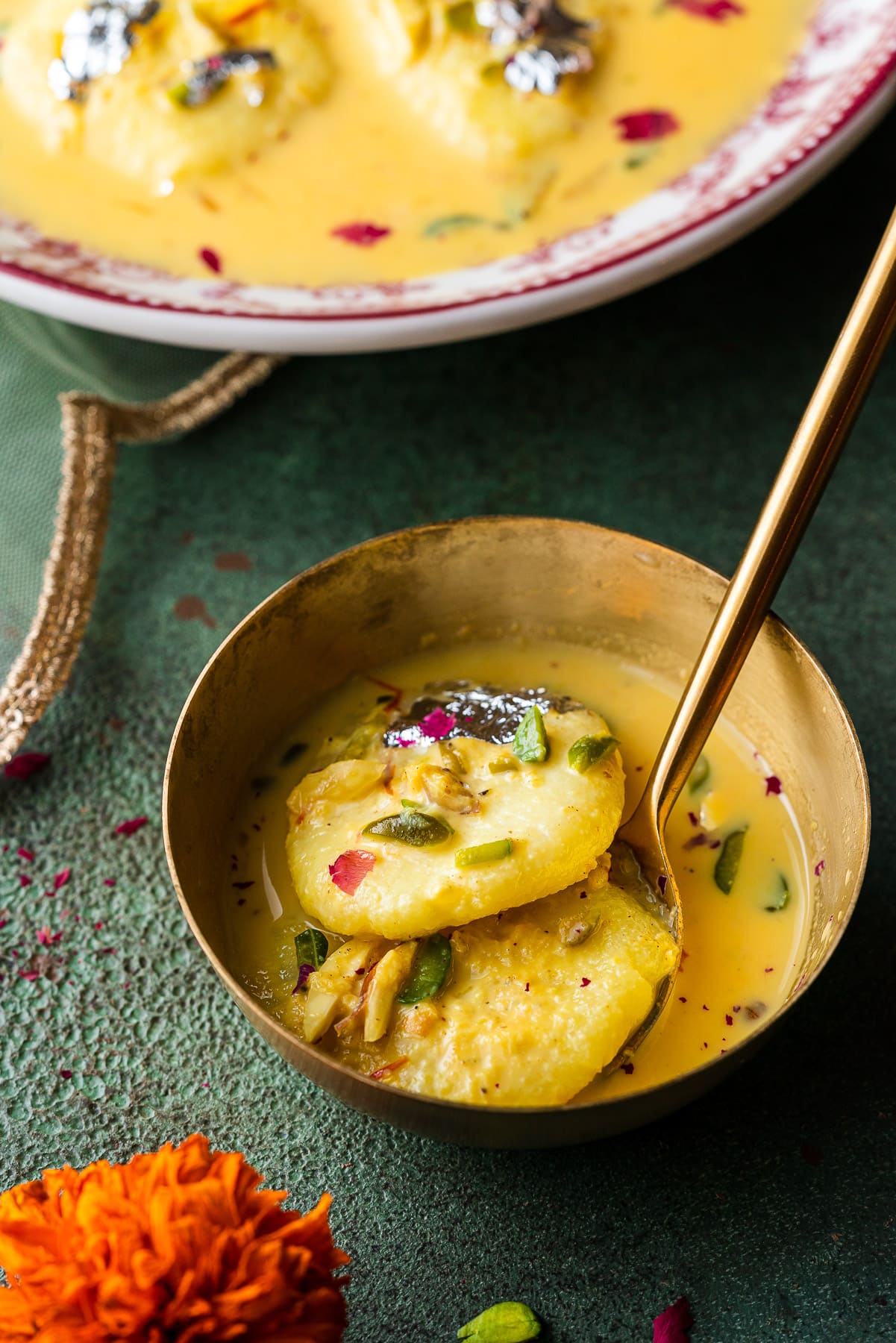
More Indian Desserts to try
Recipe
Want to Save This Recipe?
Thinking about making this recipe? Enter your email and I'll send it straight to your inbox to save for later. Plus, get new recipe inspiration from me every week!
By submitting this form, you consent to receive emails from Masala and Chai.
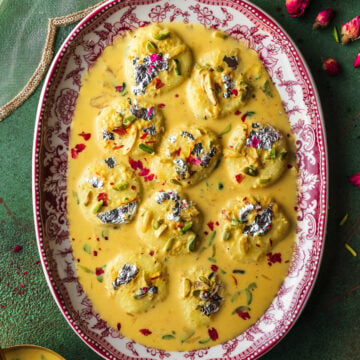
Ras Malai
Ingredients
Chenna Balls
- 1.5 qt whole milk
- 2 tablespoon lemon juice
- 1 teaspoon corn flour
- 1 cup ice cubes
Simple Syrup
- 3 cup water
- 1 cup sugar
Malai
- 2 cups whole milk
- 1 pinch saffron
- 2 tablespoon slivered almonds
- 2 tablespoon slivered pistachios
- 1 teaspoon ground green cardamom
- 2 teaspoon rosewater
- 1 cup sugar
- dried rose petals, for garnish
Instructions
Malai
- Bring the milk to a boil in a heavy bottom pot, being sure to stir in intervals to prevent the milk from burning.
- Once the milk is boiling, add the slivered almonds, slivered pistachios, saffron, ground cardamom, and saffron into the milk. Bring the milk down to a simmer and continue to cook until it reduces by about half.
- Remove from heat and stir in the rosewater. Set aside.
Chenna Balls
- In a large heavy bottom pot, pour in all the milk. Turn the heat on low to medium. Turn on the thermometer and rest it in the milk. Bring the milk to a boil (~203°F), stirring occasionally. Once it's at a boil, pour in the lemon juice and stir with a slotted spoon. Turn off the heat and allow the milk to sit for 10 minutes as the milk curdles.
- After 10 minutes, gently stir the milk with a slotted spoon to separate the curds from the whey. As soon as the whey has separated, add ice cubes into the pot to stop the chenna (milk curds) from cooking any further.
- Place a strainer over a large bowl, and line the strainer with a cheesecloth. Carefully pour the curdled milk over the cheesecloth. Gather the cheesecloth to the middle, and twist the cloth to strain out as much whey as possible.
- Transfer the chenna to a mixing bowl. Add the corn flour and start kneading the paneer until it's smooth and forms a ball.
- Roll out the chenna into a log. Cut the log into 12 pieces that weigh about 20g each. Take a piece of chenna and flatten it into a ½-1 inch thick disc between your hands.
Simple Syrup
- In wide pan or pot, bring water to a boil. Add the sugar and stir until it melts. Transfer the chenna discs into the sugar syrup and boil for 10-15 minutes, or until they double in size.
Assembly
- Scoop out the chenna discs one by one while using the back of a spoon to lightly press the excess simple syrup out.
- Transfer the chenna discs into a single layer in a baking dish. Pour the warm malai over the chenna so that it covers all of them.
- Cover the baking dish in cling wrap. Refrigerate the ras malai for up to 3 hours to allow the chenna to soak in the malai all the way to its center.
- Serve chilled with extra slivered pistachios and dried rose petals to garnish.


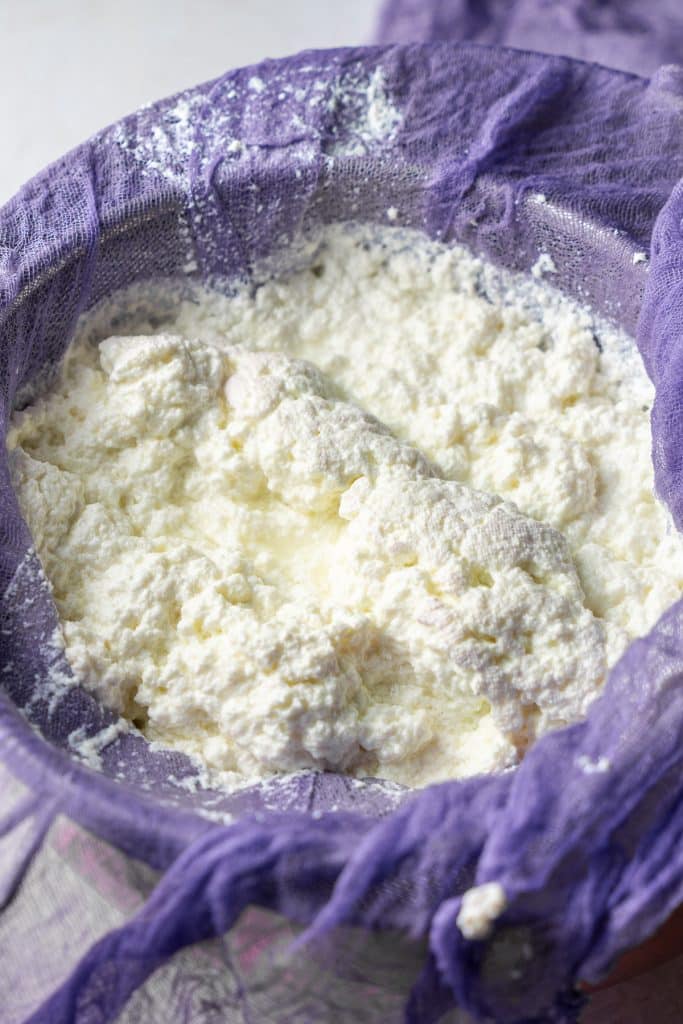
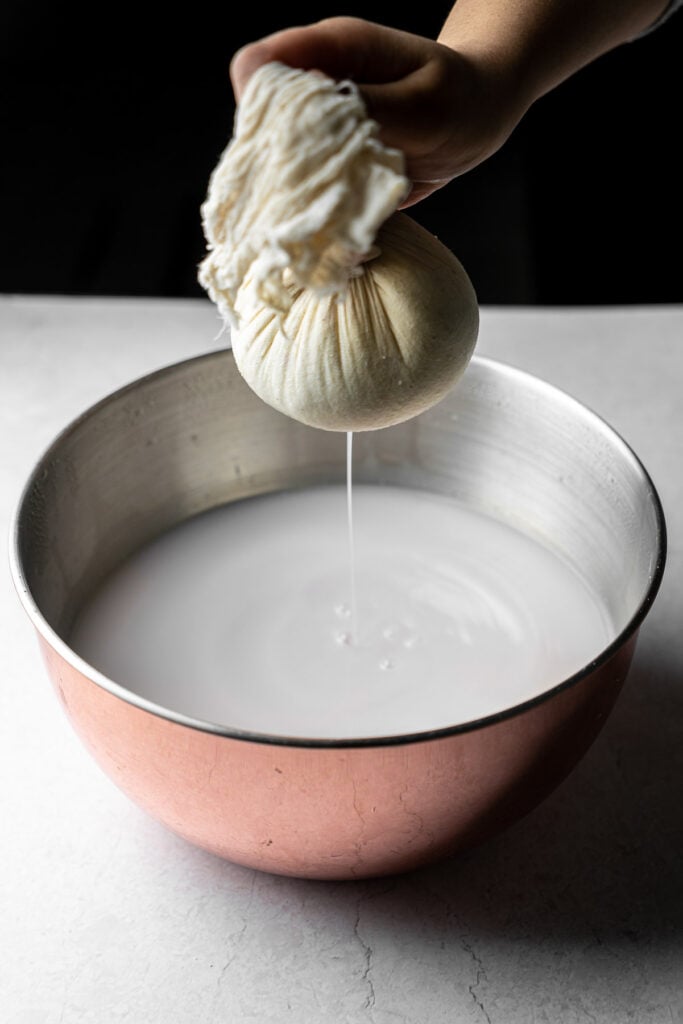
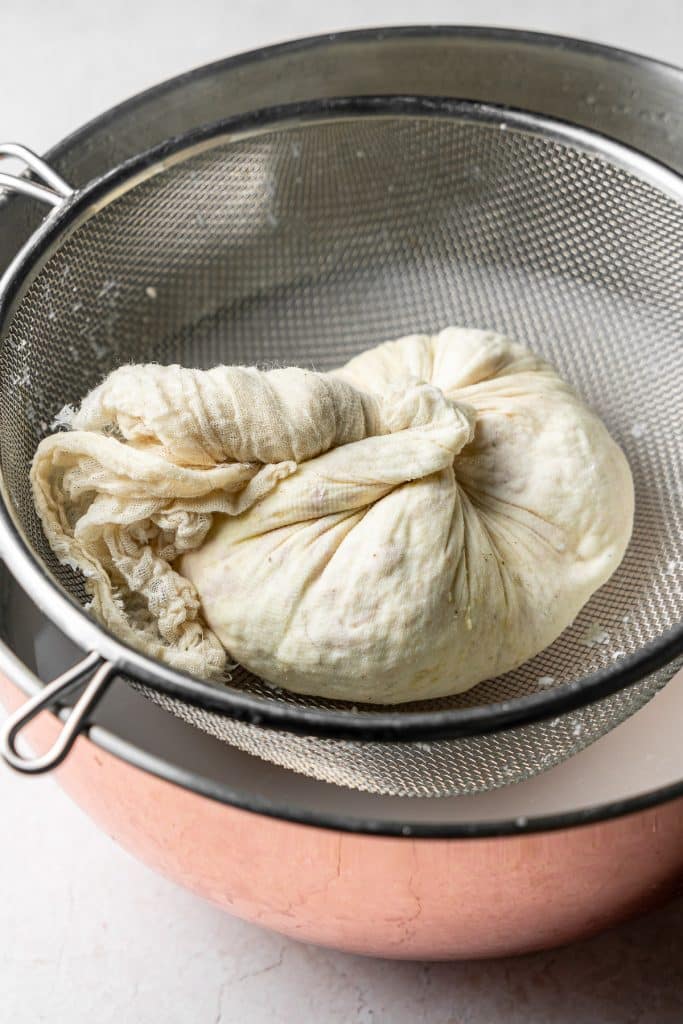
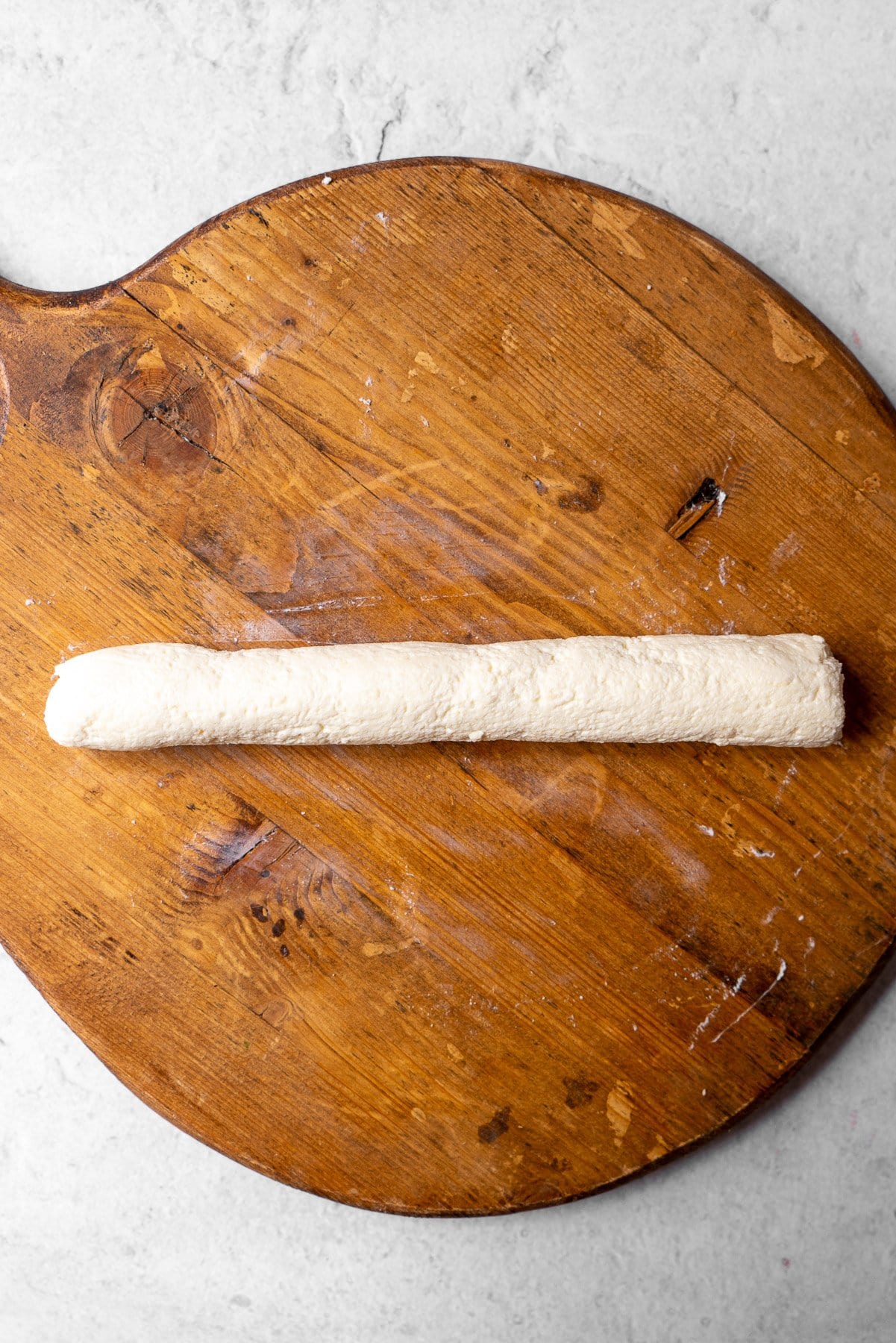
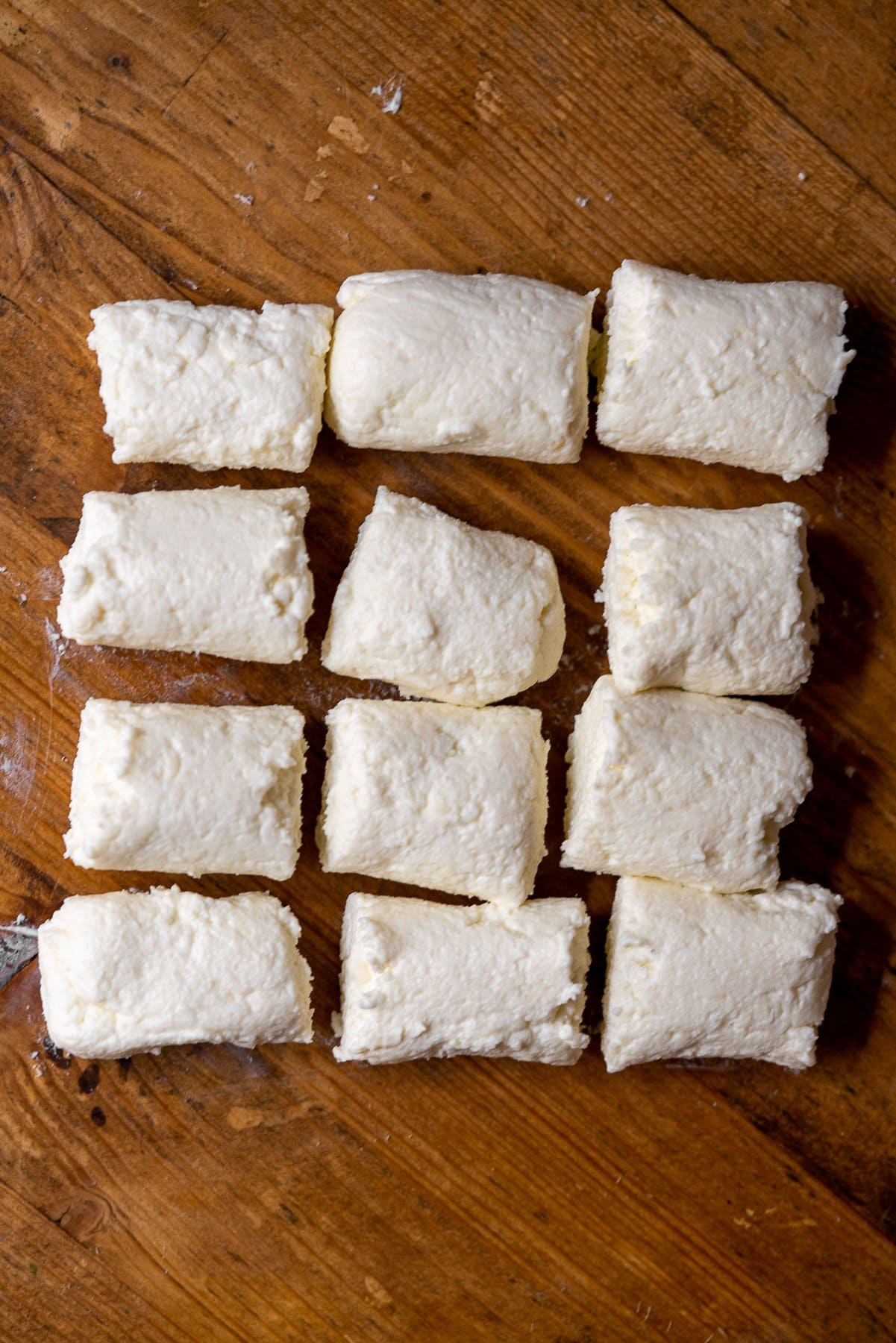
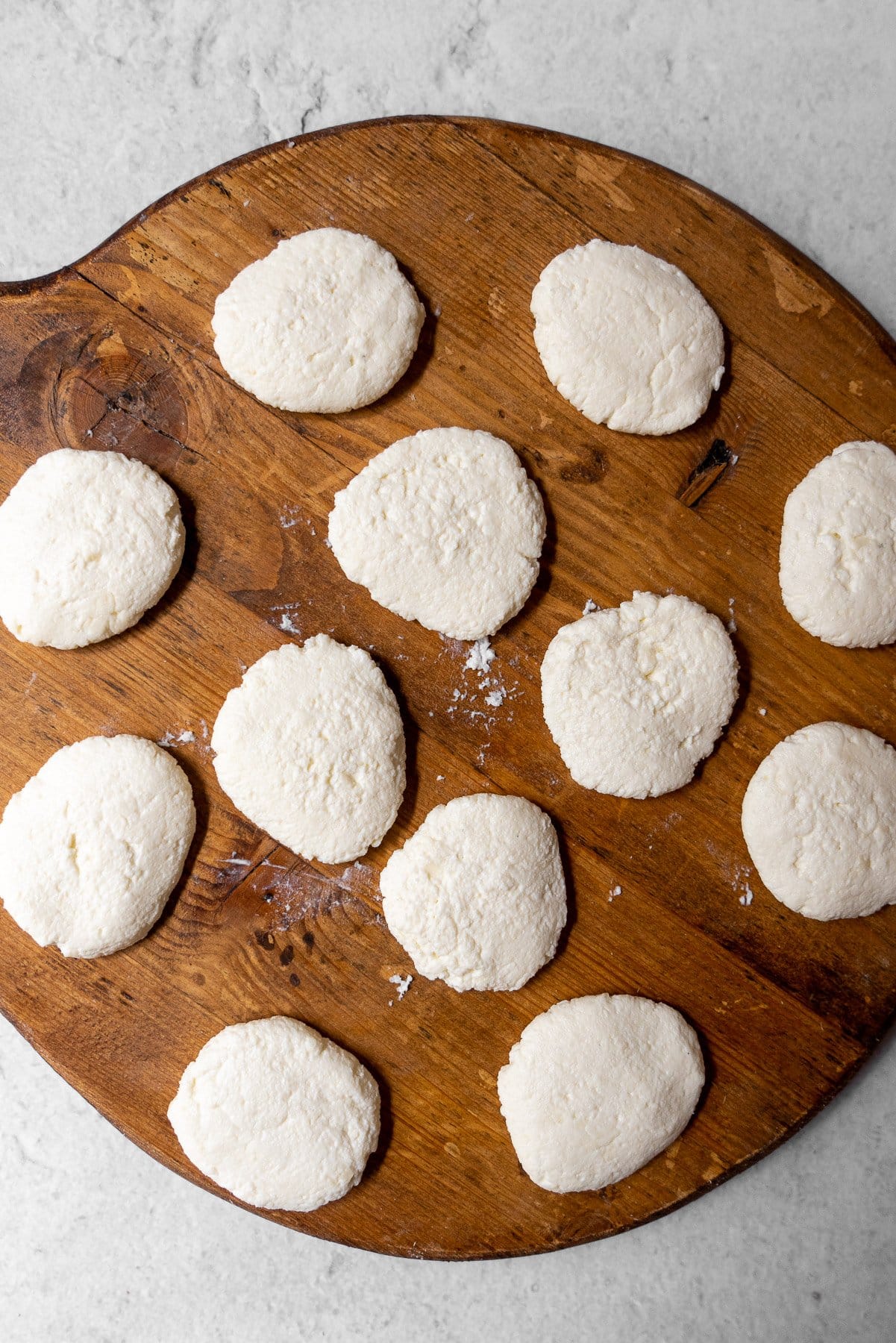
Leave a Reply